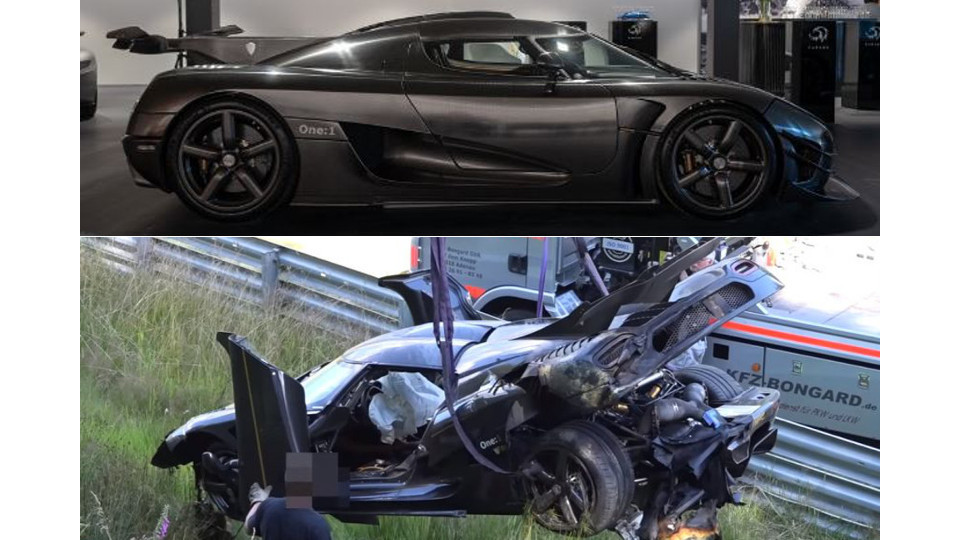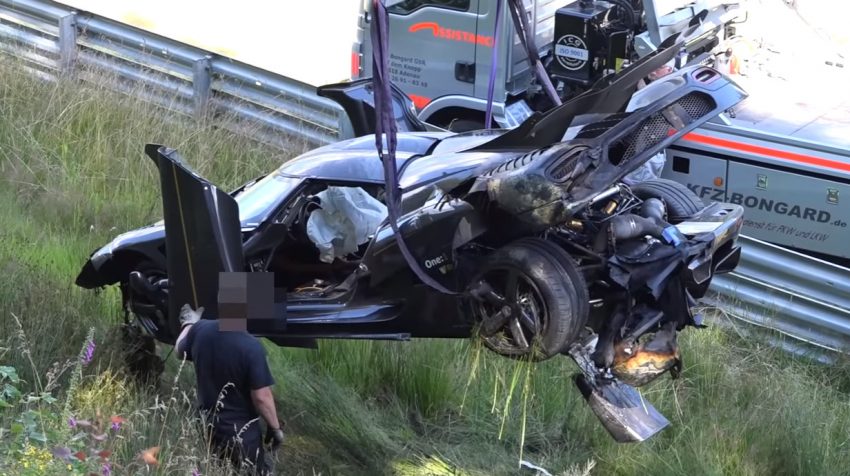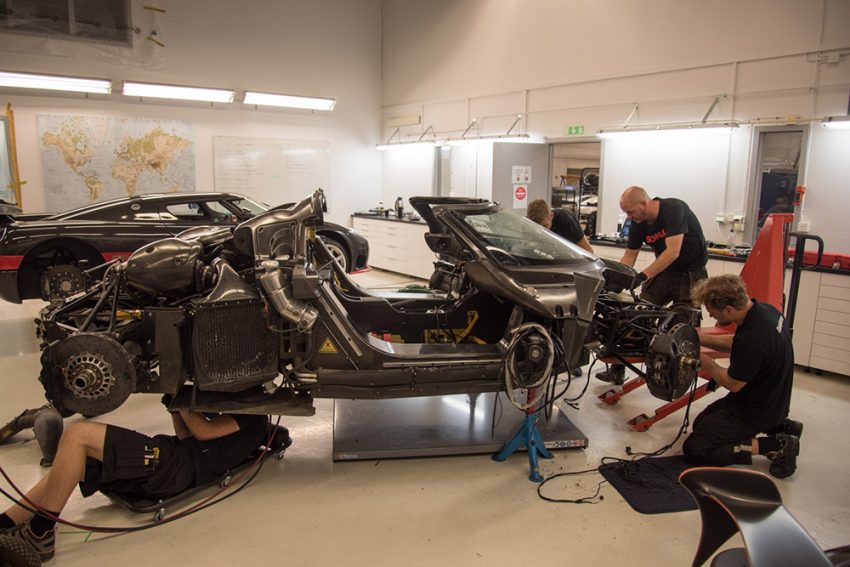
Der am Nürburgring gecrashte Koenigsegg One:1 ist wieder auferstanden
2016 verunfallte ein Koenigsegg One:1 am Nürburgring. Drei Jahre später ist das Hypercar wieder auferstanden.

Die Koenigsegg One:1 mit der Fahrgestellnummer 107 ist etwas berühmter als seine Artgenossen. Das liegt daran, dass das Kundenfahrzeug in Vorbereitung auf einen mutmaßlichen Rekordversuch am Nürburgring im Jahr 2016 in der Streckenbegrenzung gelandet und dabei auch noch gefilmt worden war – ein Garant für die rasante Bekanntheitssteigerung in der Auto-affinen Abteilung des Internets. In dem Video (siehe unten) ist zu sehen, wie der schwarze One:1 seine Runden dreht, bevor die „Grüne Hölle“ ihrem Namen alle Ehre macht. Der offensichtlich desolate Zustand des Hypercars nach dem Crash trieb damals so manchem Autoliebhaber die Tränen in die Augen – doch Koenigsegg kündigte sogleich an, das Fahrzeug wiederbeleben zu wollen. Fast drei Jahre später ist es nun so weit: Die Schweden posteten ein Foto des wieder auferstandenen One:1 #107 auf Instagram.
Koenigsegg One:1: Crash am Nürburgring im Video
Zu viel Speed & Bremsprobleme
Der Crash ereignete sich am Adenauer Forst. Wie Koenigsegg in einem detaillierten Bericht erläuterte, war ein Fehler im ABS-System die Unfallursache. Der Fahrer bliebt unverletzt.

Stellungnahme und Analyse seitens Koenigsegg vom 21.7.2016
KOENIGSEGG ANALYSIS OF NURBURGRING ACCIDENT
A Koenigsegg One:1 endured a severe crash at the Nürburgring Circuit in Germany last Monday, 18th July. The accident occurred at approximately 16:30 hours, some 3.5 hours into a session of Industry Pool testing that began at 13:00 hours.
The vehicle has since returned to Ängelholm and upon examination of both the car and the on-board telemetry, we have been able to deduce the following:
The One:1 experienced front axle brake lock-up at approximately 170 km/h on a section of the track known as Fuchsröhre before hitting the fence at Adenauer Forst at approximately 110 km/h. The impact with the fence launched the car into the air for an estimated 22 meters while it turned 180 degrees before it landed on its left rear wheel and pivoted to land parallel with the fence. The airbags, fuel shut-off and other safety systems all deployed as they were designed to do.
There was a small fire in the rear section of the car due to contact between the carbonfibre rear panels and the exhaust upon landing. This fire was extinguished by the driver using a fire extinguisher that was located inside the car.
The accident has been traced to a fault with the front left ABS wheel sensor signal.
Data analysis shows that the dashboard ABS warning light was triggered as soon as the ABS wheel sensor malfunction occurred. The small yellow ABS warning light is located centrally in the dashboard but may be difficult for the driver to see when he is wearing a helmet and concentrating on high-speed driving around the circuit. The driver may not necessarily notice any difference in the braking feel as long as he is not near the ABS braking zone, i.e. braking hard enough that it would have triggered the ABS system.
Whilst the ABS warning was activated well in advance of lock-up, data analysis shows that the driver’s brake application at Fuchsröhre was the first brake application in the ABS zone. Hence, it was the first opportunity for the driver to notice the ABS fault through the brake pedal.
Our ABS system, like most, includes a back-up feature where the rear wheels are allowed to continue rotating in the event of an ABS fault that results in the front wheels locking up. Letting the rear wheels rotate instead of locking up together with the front wheels prevents the car from rotating. Instead, the car will continue in a straight line. The system worked to specification, as can be seen by the straight skid marks left by the front tires on the track prior to the car colliding with the fence.
Our engineers spent several hours on Wednesday, July 20th, replicating the fault using a similar car at our factory test track. The left front wheel ABS sensor was disconnected and ABS-level braking force was applied. We found results that were entirely consistent with those experienced by the One:1 at the Nürburgring.
If an ABS fault is triggered in the normal course of driving, the customer would normally take heed of the warning light, stop the car and have the fault attended to. As long as heavy ABS braking is not needed the car will stay fully drivable and most people would drive it to the nearest service facility to have them examine the system. It was our severe misfortune that this fault occurred just prior to the first instance of ABS-braking into a corner during high-speed testing on the world’s most demanding test track.
While the One:1 sustained severe damage to its exterior panels and sub-frames (front and rear), the carbon monocoque chassis and airbag restraint system performed according to design specifications and protected the driver well. Examination of the vehicle at our factory in Ängelholm shows that there were no fuel leaks, no oil leaks and no hydraulic fluid leaks whatsoever, which is positively reassuring, given the force of the impact.

The carbon monocoque chassis has been examined at our factory in Ängelholm (photographed today, above). The monocoque is intact and will form the basis for the rebuild of the car in the near future, together with the engine, gearbox and many other systems. Both doors were fully operational, opening and closing in their original positions. The removable roof is fully intact and properly aligned.
Given this unfortunate and unlikely situation and given that we have the tools to further enhance our cars’ safety in this regard, we will implement software changes that will be rolled out to all applicable vehicles in the near future.
Modern Koenigseggs already have an Active Systems Warning regime in place. This is a system that is well above all legal requirements. The Active System Warning monitors all active systems in the car – the front aero flaps underneath the bumper, active ride height system, active rear wing and our active rebound dampening. If a fault is triggered in any of these active systems, a flashing light appears on the dashboard along with an ACTIVE SYSTEMS WARNING light. The car is then restricted to 100 km/h until the fault is fixed and cleared in the system. We will act immediately to include the ABS system in this Active Warning System regime. This will have the dual effect of heightening driver awareness of the fault and restricting vehicle output until the fault is fixed.
This incident will not stop us from continuing our intensive testing at the Nürburgring, but it will halt it for some time as the team behind the effort will focus on rebuilding this car before going back again. Today it is a bit hard to say exactly how long that will take but we will do it as efficiently as possible. Will we be back this year? That is also hard to say at this point, but we won’t say a definite ‘no’.
Koenigsegg Automotive AB is committed to building the world’s best performance cars. The world of high performance is inherently dangerous but a critical part of our commitment is making the cars as safe to drive as such cars can be. As is customary with severe Nürburgring accidents, our professional driver was taken to hospital for routine tests. Encouragingly, he was released later the same afternoon. We thank him for his alertness in putting out the fire directly after the impact.
We are also extremely grateful for the level of public support we have received since this incident. It is truly heartwarming.
Stay Tuned!
Link: koenigsegg.com
